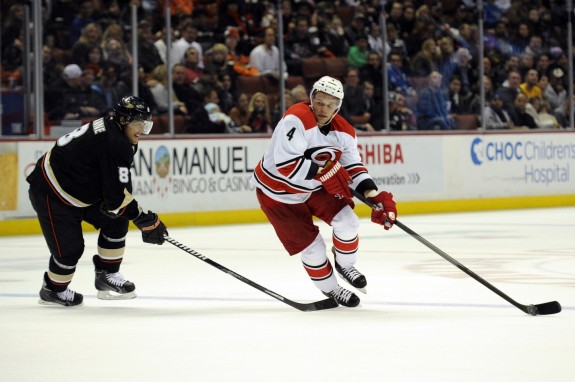This year, Justin Faulk received his first Team USA Olympic nomination. The Minnesota native is having a great year on the surface, recording three goals and 20 assists in 61 games. He’s averaging just over 23 minutes a game, and has just 33 penalty minutes. However, a closer look at the advanced statistics led me to a different conclusion and begged me to ask the question – is Faulk really one of the top defensemen in the NHL?
On the surface, Faulk’s advanced statistical numbers look fairly decent. At 5-on-5, his Corsi for% relative (essentially the team’s puck possession when Faulk is on the ice relative to when he’s off the ice) is +0.7%, his Fenwick for% relative (another measure of puck possession when Faulk is on the ice relative to when he’s off the ice) is +0.3%, and the team’s save percentage when he is on the ice is 90.6%. However, when we look at his role as a defenseman to prevent goals, Faulk has several shortcomings. Let me lay out the statistics for you (all Corsi numbers taken from Extra Skater).

Faulk Compared To Team USA Defensemen
First, I’d like to compare him to the other defensemen that were selected to represent Team USA at the 2014 Winter Olympics. If this is the company we are holding him in, I’d like to show you how he stacks up. I’ll preface the statistics by showing you first the goals against average and goaltender save percentage for each of the teams that had a defenseman on Team USA. All statistics are up to date prior to March 9th games.
Carolina Hurricanes – 2.86 GAA, 91.0 SV%
Washington Capitals – 2.79 GAA, 90.8 SV%
Anaheim Ducks – 2.32 GAA, 91.7 SV%
Minnesota Wild – 2.34 GAA, 91.5 SV%
New York Rangers – 2.48 GAA, 91.5 SV%
Pittsburgh Penguins – 2.43 GAA, 91.3 SV%
| Defenseman | Goals Against/60 minutes | Goaltender SV% when on ice | Goals Against/60 minutes 5-on-5 |
| Justin Faulk | 3.59 | 88.9% | 2.98 |
| John Carlson | 3.11 | 91.0% | 2.41 |
| Cam Fowler | 2.30 | 91.7% | 1.92 |
| Paul Martin | 2.68 | 89.2% | 2.48 |
| Ryan McDonagh | 2.70 | 91.1% | 2.27 |
| Kevin Shattenkirk | 2.04 | 90.9% | 1.98 |
| Ryan Suter | 1.98 | 92.8% | 1.54 |
| Brooks Orpik | 3.19 | 89.7% | 2.95 |
| Defenseman | Goals Against/60 minutes 5-on-5 close | Goals Against/60 minutes 5-on-5 tied |
| Justin Faulk | 3.29 | 3.31 |
| John Carlson | 2.59 | 2.18 |
| Cam Fowler | 2.05 | 2.57 |
| Paul Martin | 2.24 | 2.10 |
| Ryan McDonagh | 2.29 | 2.39 |
| Kevin Shattenkirk | 2.43 | 2.27 |
| Ryan Suter | 1.69 | 1.37 |
| Brooks Orpik | 2.58 | 2.24 |
Let’s take a closer look at these numbers. First, let’s throw out Ryan Suter. He’s clearly not from this planet and he’s preventing goals at a Nick Lidstrom-esque level with a ridiculous 1.54 GA/60 minutes while playing 5-on-5. The defenseman I want you to focus on is John Carlson. His team allows goals at a similar rate to Justin Faulk and their goaltenders save a similar percentage of the shots. However, look how much better Carlson is across the board. I’m not trying to suggest Carlson is Norris Trophy-worthy with a 3.11 GA/60 minutes when he’s on the ice, but his numbers on a similar team are clearly far superior to what Faulk brings to the table. What really impresses me is how Carlson’s numbers get better as the situation becomes more dire. His overall GA/60 minutes is 3.11 as I mentioned previously, but when you look at 5-on-5 situations where the score is tied, it’s nearly a full goal less, at just 2.18 GA/60 minutes. Faulk clearly does not stack up when compared to any of his Team USA defensive counterparts (well Brooks Orpik’s numbers look pretty bad). What happens when you compare Faulk to the defensemen on his own team?

Faulk Compared To His Teammates
On his own team, this is how Faulk ranks in several different categories when it comes to preventing goals
| Defenseman | Goals Against/60 minutes | Goaltender SV% when on ice | Goals Against/60 minutes 5-on-5 |
| Justin Faulk | 3.59 | 88.9% | 2.98 |
| Andrej Sekera | 3.34 | 89.7% | 2.75 |
| Ron Hainsey | 2.84 | 90.0% | 2.17 |
| Jay Harrison | 2.31 | 92.9% | 2.14 |
| Brett Bellemore | 2.68 | 91.0% | 1.91 |
| John-Michael Liles | 1.26 | 94.7% | 1.38 |
| Ryan Murphy | 1.88 | 93.8% | 1.77 |
| Defenseman | Goals Againt/60 minutes 5-on-5 close | Goals Against/60 minutes 5-on-5 tied | Goals For/Goals Against per 60 minutes 5-on-5 |
| Justin Faulk | 3.29 | 3.31 | -0.28 |
| Andrej Sekera | 3.06 | 2.78 | 0.01 |
| Ron Hainsey | 2.53 | 2.90 | -0.67 |
| Jay Harrison | 3.03 | 3.12 | 0.04 |
| Brett Bellemore | 2.35 | 2.47 | -0.64 |
| John-Michael Liles | 1.21 | 1.31 | 1.38 |
| Ryan Murphy | 1.89 | 2.32 | 0.00 |
What can we draw from this? Well, across the board, Justin Faulk has the worst numbers. What’s especially troublesome is his goals against/60 minutes 5-on-5 tied. This statistic looks at the goals against average when the score is tied and the teams are playing 5-on-5. Faulk has the worst goals against average on his team by far. It’s even worse when you compare him to Andrej Sekera, the other defenseman that plays a substantial amount of minutes for the club. I mostly want you to focus on the comparison between Sekera and Faulk as those two defensemen play against a similar quality of competition and both play a similar amount of minutes. Even when we factor in the number goals scored by the ‘Canes per 60 minutes when that player is on the ice, Faulk still doesn’t come out near the top for his team. First off, John-Michael Liles has played outstanding for the ‘Canes so far with a ridiculous +1.38 goals/60 minutes. However those numbers are most likely inflated due to a small sample size. Faulk on the other hand is -0.28 goals/60 minutes, a number good for 5th among the top-eight defensemen for the ‘Canes.
What Changes Are We Advocating?
Based on these numbers, what changes should ‘Canes fans hope for when Faulk returns from his injury later this week? Well for starters, I would hope that Faulk gets less crunch time minutes. Yes, he helps generate goals, but unfortunately he’s on the ice for the most goals against per 60 minutes when the score is tied or close. Faulk has played about 85% of his minutes with Ron Hainsey, so maybe that pairing needs to see less ice time in crunch time. The current pairing of Andrej Sekera and John-Michael Liles might be in line to see more important minutes and just more minutes in general. Faulk is just 21 years old and he will develop further as he gets more experience in the NHL. However, at this moment, he simply is not one of the top American-born defensemen, let alone one of the top defensemen on his own team. I think in five years we’ll see Faulk as one of the top defensemen in the NHL and a perennial Norris Trophy candidate – he’s just not there yet.